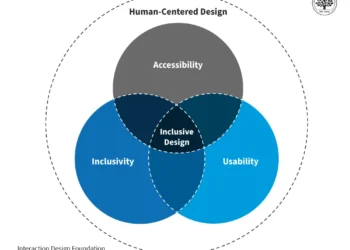I was quite struck last week at SSP 2015 in Arlington, VA by the session entitled Mind the Gap: addressing the need for more women leaders in scholarly publishing. I was struck not so much by the existence of the session, but rather by how few men were present. In fact, the lack of men prompted one audience member to inform the few men who were there that this was not a speed dating session – just in case any wanted to leave.

Here at the Scholarly Kitchen, Alice Meadows asked, in her excellent piece from 2013, Why Aren’t There More Women at the Top in Scholarly Publishing? And yet, here we are in 2015. As an Oxford-educated white male in a leadership position in publishing at an academic society, I thought that it was about time I got actively involved. And this really has very little to do with the fact I recently took a Facebook test, which indicates that I am apparently 85% female.
The essence of my message is that it is up to all of us in leadership positions to tip the scales of diversity towards inclusion and balance. In my mind the way to move forward is not to make a grand gesture and be done with it. Far more important, if somewhat less obvious, is to embark on many small steps with the goal of diversity in mind. When you hire, or when you vote for council representation, or when populate editorial boards, think actively about making sure you have diversity in your pool of candidates and face up to the fact that you might be making some small, unconscious assumptions about competence. It is not about promoting diversity over qualifications, but it is about recognizing that each small active step redresses the balance.
Let’s take a look at my organization, the American Mathematical Society (AMS). The rounded available data for 2013 shows that 58% of AMS members residing in the US admitted to being male, while 15% claimed female status. Clever mathematicians will immediately wonder about the remaining 26%* who neglected to classify themselves. Which leads me to speculate about whether they were on our planet visiting from another world, were refusing to answer on political grounds, or were just tired of answering pesky questions. Given a clear imbalance in the membership, does this in any way translate to the leadership of the AMS? Well, yes, but interestingly in 2013, 62% of Trustees and Council Members (the AMS governance structure) were male, and 38% were female. So in our case, while clearly we have much work to do, it appears that female senior mathematicians are more likely to help lead our society than their male counterparts, notwithstanding the fact that the overall representation of women in the society remains low.
I thought I would look at some other interesting data first made public through the Harvard Business Review blog in a post entitled “Are women better leaders than men?” The report, entitled A Study in Leadership: Women do it Better than Men, was published in 2012 and conducted by Zenger/Folkman, a company that focuses on leadership training. The study sampled 7,280 leaders globally (64% from the US and 36% from overseas) who had their leadership effectiveness evaluated in 2011 using the “360 Degree” evaluation tool. Of these leaders 64% were male and 36% were female – not unlike the spread at AMS. The study unsurprisingly shows that a higher percent of leaders in top management, and in fact those who report to top management, are male.
The study looked at 15 functions ranging across sales, marketing, legal, engineering R&D and so on and found that in 12 of the 15 functions females were more effective than men. In fact many of the areas where females scored much more highly than males were some of the supposedly traditional “male” roles including, legal, sales, product development, engineering and IT. Interestingly in these areas the percentage of women leaders ranged from 13-33%, lower than the proportion of women in the study. The study went on to look at competencies that lie behind the ability to lead, such as taking initiative, integrity and honesty, building relationships, collaboration and teamwork, innovation, practicing self-development etc.. For 12 of the 16 competencies females ranked above males. As the study suggests, it is interesting that we expect somehow that females would be better in competencies that involve relationship building and helping other people. The study shows this, but also finds that the starkest differences where females were far better rated than men were in areas perceived in our clichéd minds as male – areas like taking initiative, driving for results, and integrity and honesty.
The point of all this is that it is time to reframe the gender diversity issue. Women are underrepresented in leadership and yet make better leaders – whoops!
And yet, perhaps we should not be referring to this as a problem at all, but rather as an opportunity for organizations, academic societies, publishers and so on to grow through commonsense behaviors.
I for one am thinking this way. Yes I still like to watch Top Gear, but in real life men and women alike just have to internalize leadership identity and a common sense of purpose.
Further reading of interest:
Study Shows Gender Bias in Science is Real. Here’s Why it matters, by Ilana Yurkiewicz, Scientific American Blog, September 23rd, 2012
Gender and Racial Bias in Hiring, Memo, by Shelley J. Correll and Stephen Benard, University of Illinois at Urbana-Champaign, 2006
(*Note: all percentages rounded, actual figures are 58.25% male, 15.37% female and 26.38% unknown)
Discussion
12 Thoughts on "Gender Diversity: We Can Do Better"
What a delicious irony that this, presumably planned, piece has been published on the same day the Tim Hunt story broke. In essence he says Men can’t help themselves in fancying women or making them cry, so the sexes should be separated in labs.
By his analysis a more appropriate solution might be to banish men so women get the funding.
Surely a reminder of just how far we have to go.
Thanks Robert for being one of those few men in our Mind the Gap session! As you say (and as I think everyone in the room at our session agreed) this isn’t a women’s issue its a leadership issue – and it is absolutely an opportunity for our organizations and community, not just a challenge. We wanted our session to start a conversation about this at SSP and beyond – and we hope that SSP will take this opportunity to play a leadership role in that conversation and in helping effect change.
In defense of my fellow male SSP attendees, that time that session was scheduled for required a brutal choice between some of the best sessions of the meeting, including dealing with sharing networks, the burden of compliance with funder mandates, library discovery, customer feedback, metadata maintenance and a frank discussion on the actual costs of publishing. Had I not been moderating the compliance session, I have no idea how I would have chosen among the others!
Roughly 50 women made the choice that this one was important. Each time period presented difficult choices, the hallmark of a good meeting! You don’t need to defend the men that did not attend this session, or walked in, realized it wasn’t the session they were looking for and left. It was a very good start to the conversation and Robert did a nice job here drawing attention to the larger issues. Men, more men, even those not deemed by Facebook to be in large part women, are very much encouraged to be part of the conversation.
It was quite striking at the start of the session to look around and see only a handful of men in the room. It was the only session at the meeting where I saw such an unbalanced breakdown of attendees and I think it really speaks to a problem where gender diversity is viewed as a women’s issue instead of an issue which should concern everyone.
It was a great panel and I would love to see it return next year as a 90 minute session – with more of my male colleagues in attendance. In the meantime I’m happy to see the discussion continue here on the Kitchen.
I didn’t make it to SSP, but I find it noteworthy that this topic was also on the agenda at the last two conferences I attended – Kathie Olsen’s keynote at NORDP (National Organization of Research Development Professionals – US) and Paul Boyle’s plenary at ARMA (Association of Research Managers and Administrators – UK). Kathie had some fun examples of the importance of diversity in science – e.g. the fact that the first voice recognition software couldn’t recognise women’s voices because there had been no women on the team that developed it.
Both times, there has been heated debate (either out loud, or on the Twitter backchannel) about whether quotas are the answer. People who argue against quotas – as I used to – often do so because they think gender shouldn’t be a factor, and decisions should rest on qualifications and experience. This ignores the reality that gender is already a factor, and plenty of evidence shows that it already outweighs qualifications and experience – in favour of male appointees. Yes, quotas are a blunt tool, but they are a means to an end that can help us create a level playing field where women can then compete on merit from a position of equality, not one of disadvantage. Other solutions proposed at these meetings included women-only funding schemes (very contentious, but again – a short-term means to an end), more proactive policies that reward fathers for taking equal responsibility for parental care (a major disabler for women), and training on unconscious bias (starting with a simple online quiz to understand your own social attitudes – https://implicit.harvard.edu/implicit/).
Today of all days, as we see yet another respected scientist demonstrate how unconsciously and deeply the gender bias runs. Yes, it’s not the only frontier of discrimination in academia. But I’m glad to see it given another airing here – thank you!
The article has a clear bias. I take objection to ANY ‘study’ that said any large group did something ‘better’ than any other. There are cultural and biological differences between women and men, and we can discuss those, and come to some sort of understanding where opportunity is equal for all involved. I am, for one, sick of discriminatory treatment of any type.
However, and you knew there was a ‘however’, saying ‘women make better leaders’ is like saying ‘black people make better basketball players’ or better yet ‘white people make better baseball players’.. or whatever ridiculous stereotype you want to apply. It’s a farce to even consider that a cohort of billions does ANYTHING particularly better then another cohort of billions, which does not exclusively relate to their intrinsic differences biologically. Yes, there are excellent female leaders. There are also excellent small person leaders. And excellent chinese leaders. And excellent polynesian leaders. In addition, This ‘study’ is rating everyone on opinion. There are no empirical metrics whatsoever, so the entire thing is here-say and of no evaluative concern, except as a piece to find out what people think.. but that is not the same at all as to what is True.
I am so tired of seeing this kind of tripe peddled as truth. It is nothing of the kind. If you want to know the real, honest truth of it, look at things like evo psych, for a soft treatment. Or perhaps we could agree on some metrics like earning potential over time, social contribution (in the areas of doing social good by volunteering for laborious work), or other such substantive metrics. Then we could see the picture more clearly. Please stop the cheerleading already. It’s doing your cause no good.
Great essay, Robert.
Thinking hard about how editorial boards are assembled is an important but overlloked step, and as we and others have shown we have a long way to go as far as diversity on that front:
https://peerj.com/articles/542/
We argue for gender parity on boards – have the board reflect the diversity we strive for, rather than be a mirror of current shortcomings.
Again, thanks for writing and the point to the interesting studies.
Good read here – funnily enough, I just ran across this excellent video on TED about the ‘missing 33%’ required for all the leaders in mid-level positions to move up to the top – the essence of which revolves around business, strategic and financial acumen as the basis upon which further differentiators an be built.
Video link is here: http://www.ted.com/talks/susan_colantuono_the_career_advice_you_probably_didn_t_get?language=en



